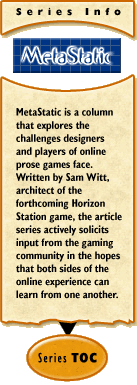 Death of Thousand Cuts, Part IV: You Don't Look So Good
Death of Thousand Cuts, Part IV: You Don't Look So Good
by Sam Witt
June 6, 2001
One of the things that is most important to the players of online games is the appearance of their characters. Strangely, most games give appearance a relatively low priority, creating static descriptions of characters that are generally only altered through the addition or subtraction of equipment.
Some go a step further and show injuries, and a rare few go even further to show illnesses or magical effects the character is currently suffering from. But that's about the extent of how a character's appearance changes over the course of their career.
In keeping with my exploration of hardship as a gameplay element, this week I'm going to look at how a character's appearance should change over the course of their lifetime.
Right off the bat, you have to take into account injuries. Nothing more radically alters the appearance of a person than a lost limb or other seriously disfiguring injury, but most characters don't have to suffer through such changes in appearance. And, of course, because they don't get mangled and mauled in permanent ways, there's no market for skills that can remove such nastiness.
In a similar vein, characters that do dirty work almost never actually get dirty. Leaving for a day at the mines? Don't worry about your clothes, they'll be just as fresh when you return at the end of the day as they are when your work begins. Which is unfortunate, because that means there won't be any call for skills and characters to keep your clothing in good repair, as well as clean and vibrantly colored.
On the other side, players that want characters who are grungy and dirty really don't have the opportunity to portray such characters. When everyone is clean and healthy all the time, there aren't any crusty drifters or filthy engineers.
The key, I think, is that all descriptors should have a range of 'appearance' modifications reflecting their cleanliness, state of repair, and any other elements that the designers find necessary. So you could have dirty, frizzy brown hair or gleaming, flowing chestnut hair on the same character, depending on how whether they had time that morning to take a shower and get a comb through their hair.
The same holds true on an overview level. By giving different elements of a character's appearance a 'prominence rating' and then displaying only those that are most prominent, at least at first glance, you can provide more unique character descriptions and show quickly what sort of lifestyle is led by that character. The dirtier or more poorly maintained a descriptor is, the higher its prominence rating. Conversely, items that are meticulously maintained and sparkling clean would also have a higher prominence rating, allowing characters to show how much they care for specific items. Seeing a very dirty man with a gleaming, well-oiled bastard sword tells you quite a bit about that character, even before you look at them more closely.
The problem with this system, obviously, is that it requires quite a bit of testing and fine-tuning, all of which will eat up a good deal of development time. Is it time well-spent? I think so, use the link below to tell me if you agree.



